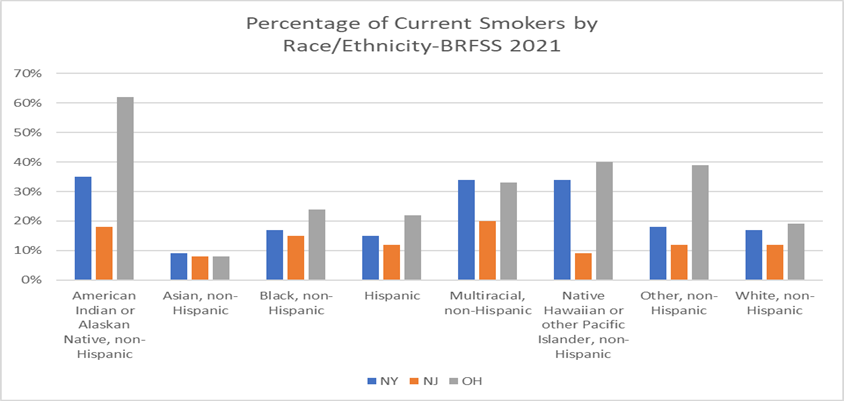Despite decades of progress in the United States, tobacco use remains a pressing public health concern as the leading cause of preventable disease, disability, and death. States and local stakeholders continue to implement tobacco control initiatives to further encourage tobacco-free living. As of September 1, 2023, New York State increased tax on cigarettes by $1 per pack; New Jersey recently implemented Breathe Easy Al Fresco, a campaign of Working Well Tobacco Free, to raise awareness of second and thirdhand smoke exposure in outdoor dining settings; in 2019, Ohio raised the minimum age to purchase tobacco products to 21 years old. These are just some examples from the IPRO QIO region, but states and communities across the country continue to implement similar work that is appropriate for their local needs.
Tobacco use among U.S. adults has trended downward since reaching a peak of 45% in the 1950s.Today, about 12% of adults indicate that they smoke cigarettes, but that percentage varies by geography and demographics such as race/ethnicity (see table below).

Source: BRFSS 2021
In an effort to increase referrals for smoking cessation counseling, the IPRO QIN-QIO smoking cessation team has been offering helpful resources to providers it has identified in high-risk tobacco use regions. Resources include information and tools to share with patients, as well as information to assist providers in better implementing tobacco use screening and counseling, including information on how to effectively code and bill for services.
Providers can greatly increase the likelihood that a patient will successfully quit by involving an interdisciplinary team. The IPRO QIN-QIO team continues to assist providers in communities with above-average rates of tobacco use, and to find ways to enhance collaboration and improve tobacco screening and counseling rates among qualified Medicare providers and associated primary care providers in these communities.
We have resources to help you!
- LINKS Portfolio: Tobacco Cessation What You Need to Know – Fast Facts
- LINKS Portfolio: Tobacco Cessation Presentation
- LINKS Portfolio: Tobacco Cessation Action Plan
- Smoking Cessation: Resources to Increase Services and Reimbursement
Sources:
- Centers for Disease Control and Prevention. (2023, May 4). Data and statistics. Smoking & tobacco use. https://www.cdc.gov/tobacco/data_statistics/index.htm#:~:text=Tobacco%20use%20is%20the%20leading,product%2C%20including%20e%2Dcigarettes.
- New York State Department of Taxation Finance. (2023, August 31). Cigarette and tobacco products tax. https://www.tax.ny.gov/bus/cig/cigidx.htm.
- Working Well Tobacco Free. (n.d.) Breathe easy al fresco. https://www.workingwelltfnj.com/blank
- Jones, J.M. (2023, August 18). U.S. cigarette smoking rate steady near historical low. Gallup. https://news.gallup.com/poll/509720/cigarette-smoking-rate-steady-near-historical-low.aspx
- Centers for Disease Control and Prevention. (2023). BRFSS: Table of tobacco use. https://data.cdc.gov/Behavioral-Risk-Factors/BRFSS-Table-of-Tobacco-Use/bq95-jg9r.